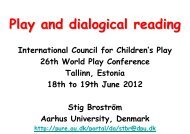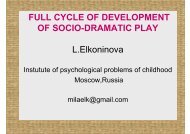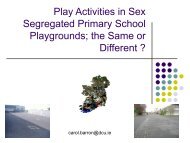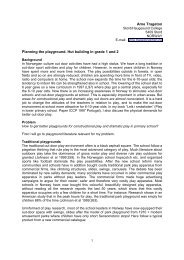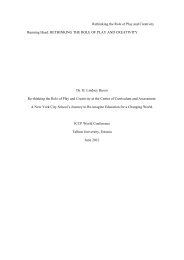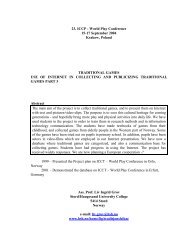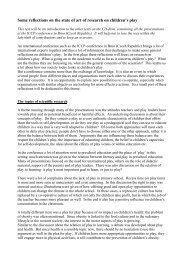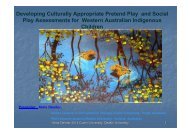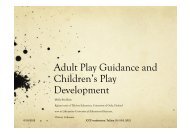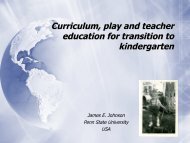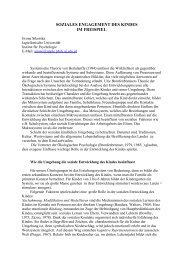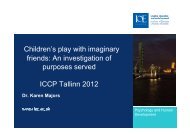Stuart Lester - International Council for Children's Play
Stuart Lester - International Council for Children's Play
Stuart Lester - International Council for Children's Play
You also want an ePaper? Increase the reach of your titles
YUMPU automatically turns print PDFs into web optimized ePapers that Google loves.
ICCP Conference paper 2012<br />
Vibrant spaces: re-configuring adults ‘providing play’<br />
Starting with Colin Ward’s assertion that children will play anywhere and with anything, this<br />
presentation will challenge the notion of adults ‘providing play’. Underpinning this phrase are<br />
numerous interconnected assumptions about play, space, adult and child that work collectively to<br />
produce a particular <strong>for</strong>m of relationship between these elements based on separation: children are<br />
apart from the adult world and need specific attention and space to be a ‘child-becoming-adult’. It<br />
assumes a dominance that not only positions children as subordinate but also by implication situates<br />
adults as providers <strong>for</strong> and protectors of children’s separateness in the special spaces and<br />
institutions of childhood.<br />
Drawing on research and observations from adult designed spaces (schools, playwork settings,<br />
museums) the presentation will consider how an alternative understanding of ‘playing’, as moments<br />
in which the limits of the real world are temporarily set to one side, reveals other ways of producing<br />
space/time and by doing so opens up the possibility of re-visioning ways of being ‘adult’ and ‘child’.<br />
Paying attention to such vibrant moments offers a chance to reconstitute the institutions of social<br />
life as co-produced spaces where adults and children can simply get on and go on together.<br />
<strong>Stuart</strong> <strong>Lester</strong> – Senior Lecturer in <strong>Play</strong> and <strong>Play</strong>work, University of Gloucestershire, UK<br />
slester@glos.ac.uk<br />
The University of Gloucestershire Post-Graduate <strong>Play</strong> and <strong>Play</strong>work distance learning programme<br />
provides a range of professional development modules <strong>for</strong> all those involved in supporting<br />
time/space <strong>for</strong> children’s play. Full details are available at:<br />
http://www.glos.ac.uk/courses/postgraduate/plp/Pages/default.aspx<br />
1 | P a g e
ICCP Conference paper 2012<br />
Introduction<br />
Along with the recognition that children play everywhere and with anything, which should stand as<br />
the first thought <strong>for</strong> any adult involved in working to support children’s play, Colin Ward (1979:86)<br />
tellingly observes that the ‘provision that is made <strong>for</strong> their needs operates on one plane, but<br />
children operate on another’. It is this notion of separate planes between adult desire <strong>for</strong> children<br />
and children’s desire <strong>for</strong> playing that this paper addresses.<br />
The Conference title, ‘Providing <strong>Play</strong>’, could be seen as deliberately provocative, inviting a range of<br />
challenges to the essentialist notion that somehow play can be provided. But the suspicion is that<br />
there remains a strong feeling that somehow adults can and should provide ‘play’. At a superficial<br />
level, this may seem like an exercise in semantics; what we intend by this phrase is not providing<br />
play per se but rather making time/spaces available in which children can play. If that is the case,<br />
then this paper has already served its purpose by raising this issue and calling <strong>for</strong> a more considered<br />
use of language from ‘providing play’ to ‘providing play spaces’.<br />
But there is a deeper and more fundamental concern here that questions the common-sense<br />
assumptions we make about play, space, childhood and by inference adulthood (recognising that<br />
questions of what it may mean to be ‘adult’ certainly do not figure as prominently as the gaze and<br />
attention we bring to meanings of ‘child’). It is these interrelated themes that are critically<br />
introduced and briefly explored here to so see what else might emerge. It adopts a playful stance to<br />
the dominant ways of thinking about providing <strong>for</strong> play. <strong>Play</strong>ful, in this context, refers to the<br />
continuous problematizing of the order of things, a ‘what if…’ approach that is at the heart of<br />
playing, to see what more may be possible. It will also draw on recent and on-going ‘experiments’ in<br />
institutional space to illustrate some of these possibilities.<br />
Common-sense production of childhood, space and play<br />
There is a danger in such a short paper of reducing complex ideas to a series of general and<br />
simplistic assertions, and while wary of this, this opening section will present some of the dominant<br />
approaches to the issue of providing play. As a starting position, the ways in which play is defined<br />
and valued in any society is part of the wider construction of childhood. In the minority world, and<br />
increasingly spreading across the globe, childhood is marked as a period of separation in which<br />
adult rationality and autonomy hold value as the most desirable qualities; not to be in possession of<br />
these qualities places children as ‘separate from’ and lacking (Lee, 2005). Separation arises from<br />
difference, used in this context as a way of placing childhood as a unitary and universal category<br />
that while being a different state from adulthood, is defined by its subordinate relationship to it<br />
(Dahlbeck, 2010: 1). Thus children, because of their immaturity, hold a special place: adults are<br />
burdened with responsibilities while children are carefree (Cunningham, 1995) Constructed as<br />
‘carefree’, childhood is part of a utopian vision in which children are redemptive angels; they hold<br />
the promise of a better tomorrow if only this promise can be actualised. Increasingly, there<strong>for</strong>e, the<br />
task of supporting children to ‘achieve their full potential’ has fallen to the institutional spaces of<br />
childhood (nursery, kindergarten, school, playground, health centre and so on). The ways in which<br />
these institutions are planned and used is a reflection of the values which any society (or the<br />
dominant powers within society) places on space and time. It marks the construction of childhood<br />
as a ‘privileged domain of innocence, spontaneity, play, freedom and emotion in opposition to a<br />
2 | P a g e
ICCP Conference paper 2012<br />
public culture of culpability, discipline, work, constraint and rationality’ (Aitken, 2001: 7). Everyday<br />
‘spacings’ and spatial routines situate children, not only controlling and guide their actions but by<br />
moral pronouncements enjoin children to commit on-going acts of self-regulation to con<strong>for</strong>m to<br />
adult expectations. Spaces are designed to progress children from immature to mature, irrational<br />
to rational. Accompanying the increasing institutionalisation of childhood is a reduction in<br />
children’s ability to gain access to public space. Children’s presence may be at odds with the<br />
dominant design principles of order, safety, predictability, visibility, and ease of (adult) movement<br />
which invariably situates children as ‘out of place’.<br />
The tracings of childhood and space briefly introduced here find further expression in the way that<br />
play is currently valued. Sutton-Smith (1997) observes we have all played and may well remember<br />
the feeling of playing, but when it comes to making theoretical statements about play we may fall<br />
into ‘silliness’. Children appear to know intuitively that what they are doing is play, yet it continues<br />
to create conceptual problems <strong>for</strong> adults (<strong>Lester</strong> and Russell, 2010). For most adults there is a<br />
deeply held and cherished belief in the relationship between play, learning and development. <strong>Play</strong><br />
represents childish behaviours that can be purposefully channelled into progress, i.e. the<br />
development of the requisite skills <strong>for</strong> becoming adult (rational, independent, and productive). It<br />
becomes an instrument to be used to ensure children grow up and out of play. From this<br />
perspective the institutions of childhood feed off play <strong>for</strong> their own purpose by promoting ‘nice’<br />
play while at the same time closing out the possibilities and potential other <strong>for</strong>ms of playful<br />
behaviour may offer. While adults may see play as the defining feature of being a child, with<br />
associated images of freedom and imagination, they are discom<strong>for</strong>ted by children’s less innocent<br />
creative acts and sanction any <strong>for</strong>m of disorderly behavior <strong>for</strong> fear that play will become dangerous,<br />
trivial, nonsensical and unproductive. Sutton-Smith (1997: 111) comments ‘the adult progress<br />
rhetoric [of play] has actually disguised the understanding of what childhood is about as a way of<br />
maintaining adult power over children’.<br />
Adult designed spaces <strong>for</strong> play invariably produce a bounded space filled with purposeful equipment<br />
and playthings, setting apart playing children from the rest of the world. Such spaces follow a fairly<br />
predictable pattern and generally make a causal connection between what is offered in these sites<br />
and what children are expected to do. Anything that contravenes designed and promoted use of<br />
space is often censured and seen as deviant behaviour. By their very design traditional playgrounds<br />
and adult managed play provision may be spaces that seek to normalize play behaviours by<br />
‘providing <strong>for</strong> play’, an adult production of space that represents a wider construction of childhood<br />
as a period of innocence, play, and a time to be ‘in nature’. While adult designed play spaces may be<br />
valued as part of a mosaic of community spaces these acts of providing play obscure a greater issue<br />
around play and space, as discussed in the following section.<br />
Thinking differently about playing and space<br />
Colin Ward (1979) reminds us that no matter what adult plans intend, children will seek ways of<br />
changing and challenging the dominant orders that seek to suppress their urges. Adult productions<br />
of space can never establish full control or finality over children’s desires; there is always an excess<br />
and space <strong>for</strong> ‘lines of flight’ (Deleuze and Guattari, 1988), moments in which intense affects enable<br />
a movement away from becoming the same, a momentary different production of time/space.<br />
3 | P a g e
ICCP Conference paper 2012<br />
In brief, the argument presented in this paper suggests that the distinctive features of playing – it’s<br />
‘as if’ quality, spontaneity, tenor of pleasure, unpredictability and the ways in which children<br />
collectively maintain control over being out of control – represent brief moments in which children<br />
can appropriate time/space <strong>for</strong> their own collective desires. Children’s play, rather than being an<br />
exercise in progress towards autonomy and rationality (the adult construct of play) becomes<br />
momentary space/time that marks the potential to create and work with difference. Aitken and<br />
Plows (2010:332), citing the work of Benjamin (1978), note that play, rather than mere imitation,<br />
marks the capacity to affect and be affected by the world; as such, ‘young people’s capacity to play is<br />
also a capacity to re-conceive history and geography, which in turn creates a moment of<br />
revolutionary possibility’. It is the ability to affect and be affected that is of importance here as it<br />
opens up the possibility to move away from humanistic and individual accounts of agency to a<br />
position in which agency may be seen as the collective desire of bodies and materials to assemble<br />
and co-create time/space in which there is a greater capacity to act, and by doing so to simply create<br />
a more joyous state of being.<br />
Such acts of playing are not transcendental or major events, but are marked by their very<br />
ordinariness, brief fleeting moments woven into the fabric of mundane routines. It is relatively<br />
straight<strong>for</strong>ward to think of everyday examples: children walking on walls rather than pavements, not<br />
stepping on the cracks between the paving stones, balancing along the kerbstones, teasing and<br />
chasing each other. Observations of children as they come out from school reveals the jostling,<br />
shouting, and other expressions of exuberance following their release from the constraints of the<br />
school classroom. And even in highly regulated educational spaces, playing will emerge, <strong>for</strong> example,<br />
when the teacher has their back turned to the class or leaves the room; ‘children doodle, pass<br />
notes, whisper, make faces, giggle, mock and satirise adults’ (Sutton-Smith, 1997: 111). The inbetween<br />
spaces of adult order also offer moments of playing, <strong>for</strong> example children pass each other<br />
in the school corridor and tag, hit, joke, make funny faces at each other and so on. They are<br />
moments when playing erupts simply to enliven the practicalities of everyday life and produce a<br />
different <strong>for</strong>m of ‘utopian hope’ which says that things can be different, that life can be momentarily<br />
better and can simply go on, producing greater satisfaction in being alive and maintaining a sense of<br />
optimism about the near-future (Sutton-Smith, 2003). Yet while they appear as ordinary events they<br />
contain potentially magical properties; through playing children enhance biological and social<br />
systems that support their capability to look after themselves and cope with the demands of an<br />
uncertain world (<strong>Lester</strong> and Russell, 2008).<br />
<strong>Lester</strong> (2011) elaborates on this theme to suggest that such everyday moments might be seen as<br />
minor political acts. Children playfully reconfigure the existing order of the world to satisfy their own<br />
desires; moments in which they ‘resist, con<strong>for</strong>m and negotiate on their own terms, even if these<br />
struggles and negotiations do not and cannot be carried out in official political arenas or follow<br />
conventional political modes’ (Kallio, 2009:6). The focus on play as minor politics invites a broader<br />
perspective that shifts focus from adults seeking to provide <strong>for</strong> play as something apart from the<br />
everyday to understanding that play is a vital sign of children’s full participation in democratic<br />
processes, as active citizens and not passive consumers of adult plans and intentions. The focus on<br />
participation also highlights that moments of playing are inherently spatial. <strong>Play</strong> spaces are not fixed<br />
or provided but are always created; they are the product of relational achievements and as such are<br />
always highly variable and constantly shifting. Space is the product of interrelations, co-created by<br />
4 | P a g e
ICCP Conference paper 2012<br />
interactions operating at multiple levels of analysis (Massey, 2005). It is always a sphere of possibility<br />
brought about by the co-existence of many bodies and materials, each with their own <strong>for</strong>ce and<br />
trajectory; it is always being produced and reproduced through everyday encounters. But what this<br />
also suggests is that spaces are sites in which power is exercised as dominant <strong>for</strong>ces seek to establish<br />
control and order. The very idea of providing play may be a reflection of such power arrangements<br />
as adults seek to impose their version of what constitutes ‘good play’ upon the design and control of<br />
space. Is it possible <strong>for</strong> adults to adopt a more playful, ‘what if…’ stance to spatial productions, to<br />
momentarily imaginatively disturb space on behalf of children (Jones, 2008)? Posing this question<br />
invites adults to pay less attention to children and more focus to disturbing their adult rationality<br />
and knowingness and by doing so create the possibility of different <strong>for</strong>ms of spatial relations and<br />
productions.<br />
Implications <strong>for</strong> providing play: an experiment<br />
What may be apparent from this brief analysis is that ‘providing play’ is something more than<br />
designating spaces and times as play spaces. <strong>Play</strong> is not a subsidiary and separate process set apart<br />
from the real world. Given the everyday, spontaneous nature of the <strong>for</strong>mation of playful moments,<br />
accounting <strong>for</strong> play in causal terms is obviously not possible or desirable. It should also be clear that<br />
given the nature of ‘playing’ as discussed in the previous section, there can be no template or<br />
blueprint <strong>for</strong> play provision. Attention switches not to providing play, but rather to the conditions<br />
under which playfulness may thrive. This is an important distinction as it pays attention to more<br />
general conditions under which social, affective and material resources may facilitate the expression<br />
of children’s playful desires, what may be referred to as ‘play enabling spaces’ or the ‘playful feel of<br />
space’. While a full discussion of this is beyond the scope of this paper, a glimpse of what this might<br />
mean is presented by a brief exploration of an ‘experiment’ – <strong>Play</strong>ful Surprises’ - being carried out by<br />
Manchester Museum (MM) as part of a wider ‘Happy Museum’ project 1 . The use of the term<br />
‘experiment’ is again deliberate, but not in the sense of controlling all parameters and variables, as<br />
in a scientific experiment, to produce a ‘truthful’ or rational account. Rather, as with play itself, a<br />
creative <strong>for</strong>m of experimentation pays attention to that which is not yet known, it concerns that<br />
which comes about through moments of nonsense and because of this demands an approach that<br />
respects the very qualities of play itself. From this perspective governance and planning are<br />
deliberately speculative, outcomes are volatile, and problems are not ‘solved’ once and <strong>for</strong> all, but<br />
are rather constantly recast and re<strong>for</strong>mulated (Hillier, 2005). Questions become issues of<br />
problematisation, of continuously asking ‘what if’ rather than seeking neat solutions, which are<br />
generally only neat in terms of their own internal logic.<br />
Strategic spatial planning as strategic navigation is a per<strong>for</strong>mance of risk-taking, of<br />
not being in total control and of transcending the technicalities of planning practice<br />
to create an open reading frame <strong>for</strong> the emergence of unprecedented events<br />
(Rheinberger, 1997: 31).<br />
MM are currently working to establish a more playful space <strong>for</strong> children and families. However,<br />
rather than provide dedicated and segregated space or ‘interactive exhibits’ <strong>for</strong> children’s play<br />
1 For more details about this programme see: http://www.happymuseumproject.org/<br />
5 | P a g e
ICCP Conference paper 2012<br />
activities (which is a common feature of many cultural institutions) the Museum have taken a bold<br />
step to think about how the entire museum space may be more playable. This involves thinking<br />
differently about children’s presence in institutional space and to invite children and their families to<br />
use museum space in more playful and creative ways. The connection between ‘happiness’ and play<br />
is well-established (see <strong>for</strong> example <strong>Lester</strong> and Russell, 2008); playing may be distinguished by a<br />
tenor of pleasure as the limits of the real world are temporarily set to one side by asking the<br />
question ‘what if…’ and responding with behaviours that are marked by ‘as if…’. It is a process of<br />
problem creation, the probing and placing of space, bodies, materials, and so on in novel <strong>for</strong>mations<br />
to see what more they can do. Strange juxtapositions and surprises in space may initiate moments<br />
of playfulness, different sensations may provoke novel movements, humour is generated through<br />
incongruity and so on. The term ‘feel of space’ is important here as it recognises that museum space<br />
is more than a physical environment displaying objects. As a Victorian (and protected) space,<br />
children largely move through the museum as passive observers of artefacts and in<strong>for</strong>mation. The<br />
experiment has sought to open up more possibilities <strong>for</strong> playful engagement with space, materials<br />
and other bodies. Following some initial workshop sessions with gallery staff, a series of ‘what if…’<br />
disturbances have been injected into the space, not with any pre-determined outcomes, but simply<br />
to see what happens. Thus, in one gallery, a member of staff simply laid a length of kitchen roll along<br />
the middle of the floor and stood back. One child wandered alongside, asking his father ‘what is this<br />
<strong>for</strong>’ and receiving a reply ‘I don’t know’. Shortly afterwards, another child started to walk along the<br />
roll, careful to both stay on the paper and also not to tear it. More children followed, and as they<br />
reached the end turned around and started to walk back. This of course created a further challenge<br />
as children moving in opposite directions now had to negotiate their way past each other. At one<br />
point the length of paper was torn, and the children quickly moved in to tearing up the remainder of<br />
the length of paper with their feet, leaving fragments of kitchen roll scattered across the floor. In<br />
another gallery, a member of staff had taped out a hopscotch grid, and this immediately invited<br />
children and adults to move through this space differently, creating moments of playful lingering as<br />
children played together. Numerous other examples of disturbance have been attempted, all with<br />
the same approach of wondering what might happen if….. But not only has this started to change<br />
the ways in which children (and adults) move through the museum, it has aroused a sense of<br />
curiosity among the staff and an increased sensibility and alertness to the ways in which children can<br />
develop moments of playfulness as they move through the space.<br />
Conclusion<br />
What is suggested here is that traditional ways of thinking about ‘providing play’ may miss the very<br />
point about this <strong>for</strong>m of behaviour. Our preoccupation with the deliberate creation of segregated<br />
and purposeful spaces <strong>for</strong> play glosses over the nature and benefits of children playing anywhere<br />
and everywhere. Rather than paying direct attention to play, a focus on conditions that might<br />
support playfulness may offer a more promising stance and by doing so begin to <strong>for</strong>mulate<br />
approaches to spatial design (both public and institutional) that acknowledges children’s full right to<br />
participate as active citizens. Spatial design, in this sense, does not relate simply to the physical<br />
conditions of space, but also to the feel of space and the ways that adults and children may initiate<br />
and share playful moments of being together and apart. But there are further benefits from this<br />
process; the injection of disturbance into spaces may surprise, and open adults up to a greater<br />
sensibility of what it might mean <strong>for</strong> children and adults to get on together. Children’s play reminds<br />
6 | P a g e
ICCP Conference paper 2012<br />
adults that it is always possible to expose the common-sense productions of space to critical<br />
scrutiny, to make the everyday more vibrant, and by doing so reveal that there are other ways of<br />
being in the world (<strong>Lester</strong>, 2012).<br />
7 | P a g e
ICCP Conference paper 2012<br />
References<br />
Aitken, S (2001) Geographies of Young People. Routledge: London.<br />
Aitken, S and Plows, V (2010) Overturning assumptions about young people, border spaces and<br />
revolutions. Children’s Geographies, Vol. 8 (4): 327-333.<br />
Benjamin, W (1978) Reflections: essays, aphorisms, autobiographical writings. New York: Harcourt<br />
Brace Jovanovich. Cited in Aitken, S and Plows, V (2010) Overturning assumptions about young<br />
people, border spaces and revolutions. Children’s Geographies, Vol. 8 (4): 327-333.<br />
Cunningham H (1995) Children and Childhood in Western Society Since 1500. Harlow: Pearson<br />
Education.<br />
Dahlbeck, J (2010) On Childhood and the Logic of Difference: Some Empirical Examples. Children and<br />
Society, Vol. 26(1): 4-13.<br />
Deleuze, G and Guattari, F (1988) A thousand plateaus: capitalism and schizophrenia. London:<br />
Continuum.<br />
Hillier, J (2005) Straddling the post-structural abyss: between transcendence and immanence?<br />
Planning Theory, Vol. 4(3): 271-299.<br />
Jones, O (2008) True geography [ ] quickly <strong>for</strong>gotten, giving away to an adult-imagined universe.<br />
Approaching the otherness of childhood. Children’s Geographies, Vol. 6(2): 195-212.<br />
Kallio, K (2009) Between social and political: children as political selves. Childhoods Today, 3(2): 1-22.<br />
Lee, N (2005) Childhood and Human Value. Maidenhead: Open University Press.<br />
<strong>Lester</strong>, S (2011) Moments of nonsense and signs of hope: the everyday ‘political’ nature of children’s<br />
play. Paper presentation at IPA conference, Cardiff, July 2011.<br />
<strong>Lester</strong>, S (2012) ‘We are just playing’. Shopping Hour, Issue 8: 16-21.<br />
<strong>Lester</strong>, S and Russell, W (2008) <strong>Play</strong> <strong>for</strong> a Change - <strong>Play</strong>, policy and practice: A review of<br />
contemporary perspectives. National Children’s Bureau: London.<br />
<strong>Lester</strong>, S and Russell, W (2010) Children’s Right to Pay. An examination of the importance of play in<br />
the lives of children worldwide. Working Paper No. 57, The Hague, The Netherlands: Bernard van<br />
Leer Foundation.<br />
Massey, D (2005) For space. London: Sage.<br />
Rheinberger, H (1997) Towards a History of Epistemic Things. Stan<strong>for</strong>d, CA: Stan<strong>for</strong>d University<br />
Press.<br />
Sutton-Smith, B (1997) The Ambiguity of <strong>Play</strong>. Cambridge, MA: Harvard University Press.<br />
Sutton-Smith, B (2003) <strong>Play</strong> as a Parody of Emotional Variability. In D Lytle (ed) <strong>Play</strong> and Educational<br />
Theory and Practice, <strong>Play</strong> and Culture Studies, Vol. 5. Westport: Praeger.<br />
8 | P a g e
ICCP Conference paper 2012<br />
Ward, C (1979) The Child in the City. Harmondsworth: Penguin.<br />
9 | P a g e



